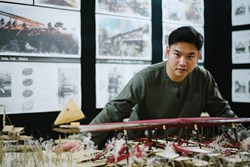Ties van Roij from Waipapa Taumata Rau, The University of Auckland, Te Pare School of Architecture and Planning is a finalist for his project 'FALE I NEI, FALE I NĀ - THE VĀ BETWEEN US'.
Project description
FALE I NEI, FALE I NĀ is a project about architecture as a living classroom. It poses an urgent question: How can a culturally responsive structure reconnect Pacific children to their heritage, their families, and one another?
The design centres on the fale, an open, communal Samoan structure that embodies reciprocity, visibility, and shared space. Guided by the proverb "E sui le fauga, ae to mau pea le fa'avae" (the form may change, but the foundation remains), the project contemporises the fale without losing the cultural values at its core.
I personally designed this fale and coordinated its approval pathway, securing resource consent, building consent, Ministry of Education approval and complete engineering signoff for construction. My father helped me build this fale by hand. Every lamination, every curved beam, every post, every screw, this project was built by our hands together. The design centres on belonging, storytelling, and participation. Its open structure invites tactile, outdoor learning and restores a sense of vā, the relational space between people.
Storytelling is embedded across the project. I developed three pedagogical tools in collaboration with mana whenua, students, teachers, and whānau, each translating cultural knowledge into interactive learning experiences: the feke (octopus) and its Pacific voyaging stories, the star constellations that reappear in the roof, and the tectonics of the fale itself. CNC-engraved roof panels extend this narrative further, with each rafter carrying stories from the diverse Pacific cultures represented within the school community. Guided by mana whenua, the project was grounded in tangongitanga, innovation that maintains cultural continuity. The CNC carving process was embraced as a fitting, modern method for carrying both Māori and Pacific narratives into the structure.
This fale bridges the past and future, land and people, and the children who will carry these stories forward into the future.






